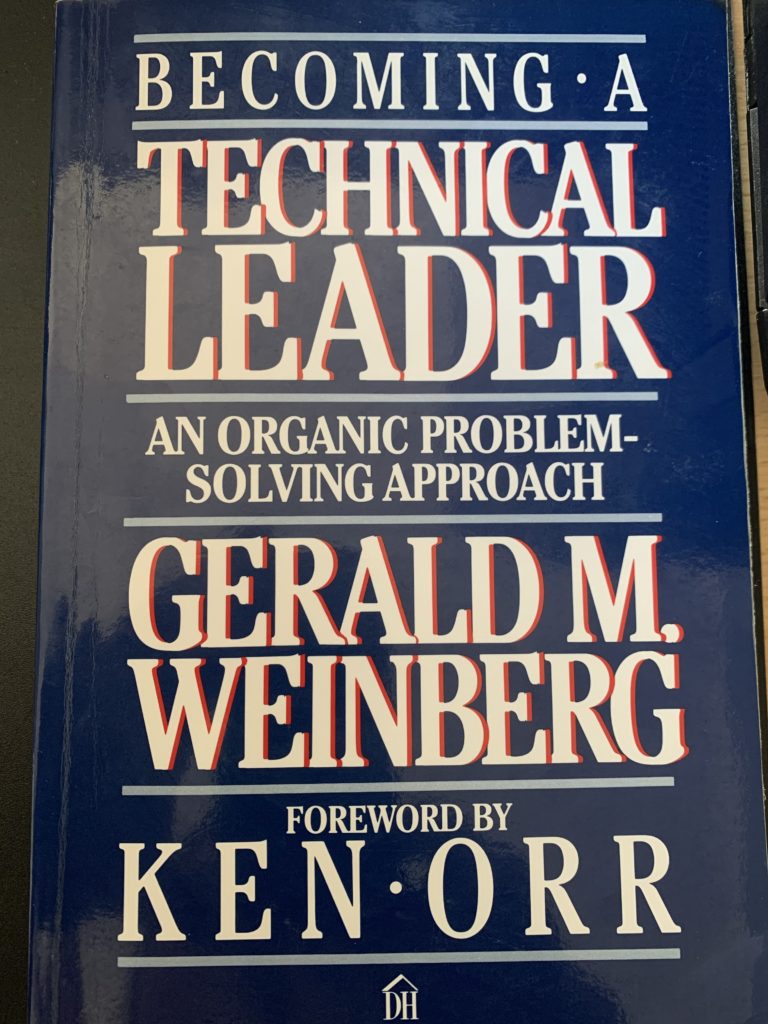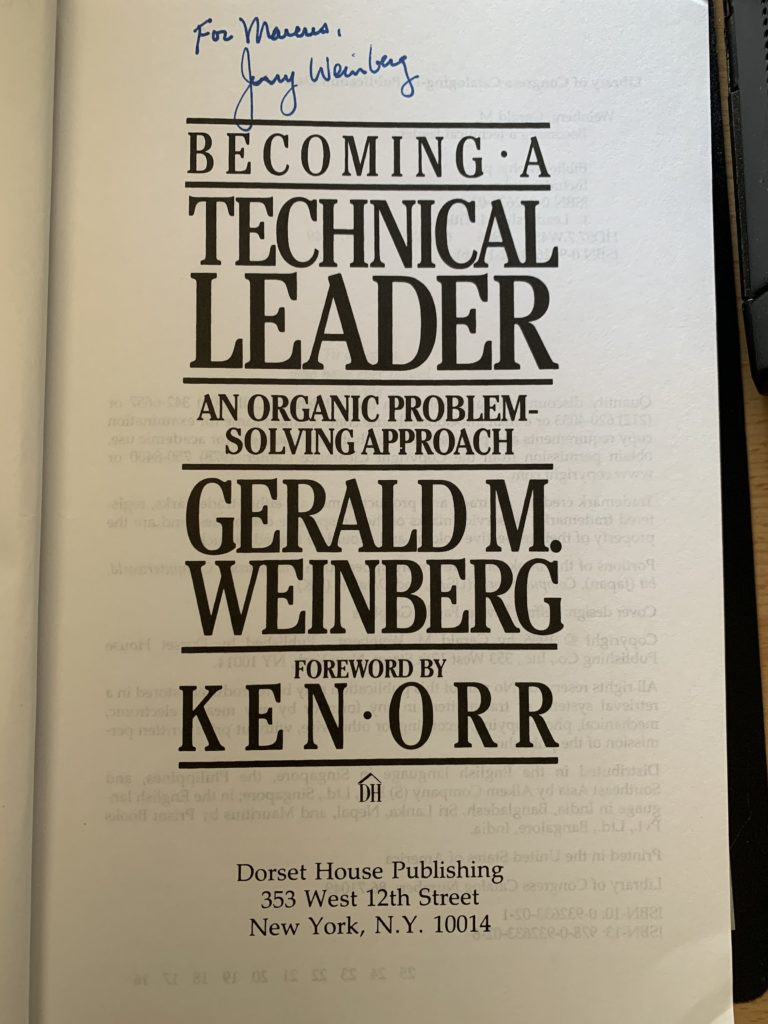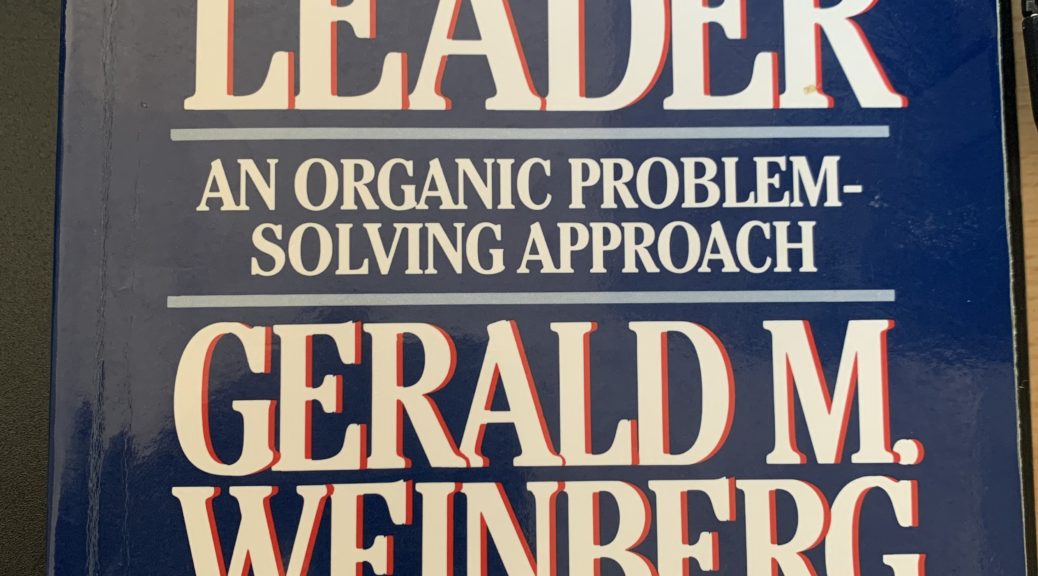It’s been four years since – sadly – Gerald M. “Jerry” Weinberg passed away. Ever since then, I struggled with some public mourning about him, until recently I had just the right idea. In the coming weeks, I will publish a review of a book I read that Jerry either wrote himself or is about some of his work. I struggled with the order I want to go for these books, chronological, topic-wise, in the order, I read them. Even after consulting my network, I don’t have a clear picture there, so I will basically just go with “whatever I want to do this week”. So, the first book I picked is Becoming a technical leader – An organic problem-solving approach published by Dorset House in 1986.

I’m so glad that I took this book with me when I attended the Problem-solving Leadership (PSL) class in Albuquerque, New Mexico back in 2011, and had the opportunity to meet Jerry in person for the first (and only time). I asked him to sign my copy of the book not only because it fitted the topic of PSL, but I think it’s the first book I read by Jerry, ever.

So, let’s dive in what I remember from the book after all these years.
The general model and approach
In general, Jerry describes his MOI model regarding leadership: motivation, organization, and innovation. A fourth piece deals with transforming, i.e. changing things on a group of technical persons.
Motivation
On motivation, Jerry’s book is pre-dating Dan Pink’s book on the matter by a few years. While skimming through the table of contents for this review, I realize there is probably more in here that I took by hears, i.e. “Help should come natural”, the Satir interaction model, and congruence. I attributed many of these models to different books of his, yet, wasn’t fully aware how much in my past the first introduction had been.
Organization
Over the years, my thoughts on the organization part have faded as well. While going through the table of contents again, I see some great pearls of wisdom in here as well. Jerry names the four obstacles to organization the following:
- playing the Big Game (I don’t recall what that was at all)
- organizing people as if they were machines (oh boy, guilty as charged)
- going the work yourself (I plead guilty to this second charge as well)
- rewarding ineffective organizing
Just by reading the headings, I get an imagination of what lies in there. Even though I seem to have forgotten many of the pearls surrounding it, I sense that my thoughts reconnect with what Jerry would say about these different topics.
Innovation
Right from my head, I had the most vivid recollections from this part: innovation. In the first few chapters of this part, Jerry describes the biggest obstacles to innovation, namely: self-blindness, the no-problem syndrome, and the belief in single solutions.
Of course, Jerry continues to offer solutions to overcome these shortcomings. To tackle self-blindness our human innovation driver stems from learning mistakes. The no-problem syndrome is overcome by what many in academia do: copy an existing solution, thereby stealing it. Lastly, the opposite of believing in single solutions is copulation of two existing good ideas into an even greater new one. I recall referring back and forth to these three archetypes for innovation over the years, often revisiting mistakes, copying, and copulation whenever a problem regarding innovations came onto my plate.
Transformation
Regarding transformation, I first thought, that I had more livid memories from his change book in the Quality Software Management series. Then it dawned on me, that Jerry actually challenged me about changing things in my daily routine. His point was to change a small thing that you usually do on auto-pilot. In my instance, I went for a different Saturday morning breakfast routine back in the day. At the end of the weekend, I noticed how just that tiny bit changed my perception of the whole weekend. I think that’s a pretty powerful point, and there is so much you can change in your daily routine to get used to changes yourself. Take a different drive to work, change your breakfast, shuffle things in your morning hygiene routine – and observe what else changes during your day. Arrive early at work, arrive late at work, sit at a different desk, there are so many things in our daily life that we appear to do on auto-pilot. Just changing one thing can have a butterfly effect to change your whole day, and even your whole life.
My main takeaways
After all these years my main takeaways from Becoming a technical-leader were the innovation model, changes in your daily routine, and journaling. In a few introduction sections, Jerry speaks about leadership, and the best thing to start your leadership journey probably is to start a daily five minutes personal journal. If I recall correctly, I made some of my personal journal entries public, but also kept many of them to my own. Even though I may have given up my personal journal over the years, I sense a deeply personal reflection every now and then that still stems from me learning about the personal journal lesson from Jerry.
One piece of advice before you head out to get a copy of Becoming a technical leader – or any other Jerry Weinberg out there: Over the years, I had conversations with very many people about his books. For some, Jerry brings the same value as to me, while others found his books quite unreadable. There did not appear to be an in-between. I always enjoyed the timeless way Jerry wrote his books with many nuggets of learning still relevant after decades. Since Becoming a technical leader brought me a quite positive start, I decided to continue reading his books.

“playing the Big Game” – I’ve not read this (nor anything yet by Jerry Weinberg, though he remains on my “to find” list) – but i recognise this as an obstacle to organization, because I’ve seen it “in action”.
What I saw was senior people in an organisation concentrating on mixing with the Great and Good, and seeing themselves as top-level Movers and Shakers well beyond their real level of influence or competence. Whilst they were doing this, they were leaving the business of organising the actual business to people further down the management chain who had their own ideas about doing things and may not have been on the same page when it came to corporate objectives and goals (for good or ill).
Robert,
Correct.
The “Big Game” is all the maneuvering, gossip, and palace intrigue over the hierarchy, power, and perks of the positional power in the organization.
John Boyd would refer to it in his “A Person at the Crossroad of their Life/Carrer: To BE, or To DO. – choose one.” The Big Game is all about the political maneuvering to becoming “The General.”